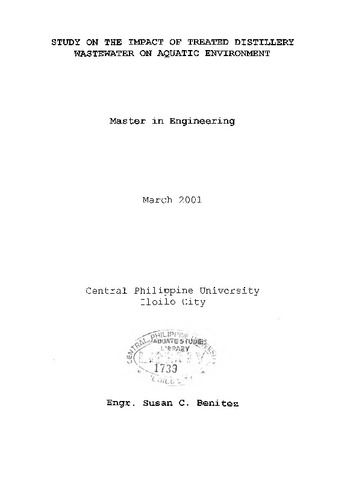Study on the impact of treated distillery wastewater on aquatic environment
| dc.contributor.adviser | David, Fely P. | |
| dc.contributor.author | Benitez, Susan C. | |
| dc.date.accessioned | 2021-10-15T08:04:37Z | |
| dc.date.available | 2021-10-15T08:04:37Z | |
| dc.date.issued | 2001 | |
| dc.identifier.citation | Benitez, S. C. (2001). Study on the impact of treated distillery wastewater on aquatic environment (Unpublished Master’s special paper). Central Philippine University, Jaro, Iloilo City. | en_US |
| dc.identifier.uri | https://hdl.handle.net/20.500.12852/1577 | |
| dc.description | Introduction and statement of the problem | en_US |
| dc.description.abstract | Rationale/Introduction of the study: Distillery is an industrial plant that produces high strength wastewater. With the increasing awareness for environmental concerns, the Department of Environment and Natural Resources (DENR) mandated all industries to put-up (multi-million) wastewater treatment facilities to abate or alleviate the environmental impact of its discharged wastewater. Asian Alcohol Corporation (AAC) in Pulupandan, Negros Occidental is a distillery plant that produces Ethyl Alcohol from molasses for beverage, food and pharmaceutical. With molasses as its raw material for alcohol production, the wastewater (slops) after alcohol extraction has a Biochemical Oxygen Demand (BOD) between 15,000 - 35,000 mg/L. This wastewater with temperatures of about 65 - 75°C can cause thermal disturbance and high organic loading to the receiving body of water, if not treated prior to discharge. At AAC, this wastewater is treated using Anaerobic, Thermophillic Biodigestion and solid separation that reduces the BOD to about 900 mg/L or less and which reduces the temperature to about 55°C - and at the same time generates methane used for fuelling the Bioler. The Boiler generates steam for the Turbo-generator that gives power to the entire distillery plant. According to Burton and Tchobanoglous (1991), disposal can be viewed as the first step in a very indirect and long-term reuse. In the case of AAC, treated wastewater disposal is by discharge into Guimaras Strait. AAC has complied with all the DENR standards, however despite of this, AAC continuously improves the existing Wastewater Treatment Plant (WTP) operations. This study is focused on the possible effect of the discharged treated wastewater into the fishes in Guimaras Strait along the AAC costal area. Statement of the Problem: General Objective: This research was conducted to evaluate the Impact of the Treated Wastewater on Aquatic Environment using Tilapia, Milk Fish and methanogenic bacteria as the bioassay organisms. Specific Objectives: Specifically, this study aimed to: 1. Establish the toxicity of the wastewater on aquatic life 2. Determine the effect of the wastewater on fish survival 3. Determine the effect of the wastewater on fish growth 4. Give recommendations on the potential use/ potential harm of the discharge of wastewater | en_US |
| dc.format.extent | 19 leaves | en_US |
| dc.language.iso | en | en_US |
| dc.subject.ddc | GSL Theses 620.0072 B437 | en_US |
| dc.subject.lcsh | Distilleries--Waste disposal | en_US |
| dc.subject.lcsh | Distilleries | en_US |
| dc.subject.lcsh | Sewage | en_US |
| dc.subject.lcsh | Sewage--Purification | en_US |
| dc.subject.lcsh | Sewage disposal plants | en_US |
| dc.subject.lcsh | Toxicity testing | en_US |
| dc.subject.lcsh | Sewage--Toxicology | en_US |
| dc.subject.lcsh | Fishes--Growth | en_US |
| dc.title | Study on the impact of treated distillery wastewater on aquatic environment | en_US |
| dc.type | Special paper | en_US |
| dc.description.bibliographicalreferences | Includes bibliographical references | en_US |
| dc.contributor.department | School of Graduate Studies | en_US |
| dc.description.degree | Master in Engineering | en_US |
| local.subject | Asian Alcohol Corporation | en_US |


